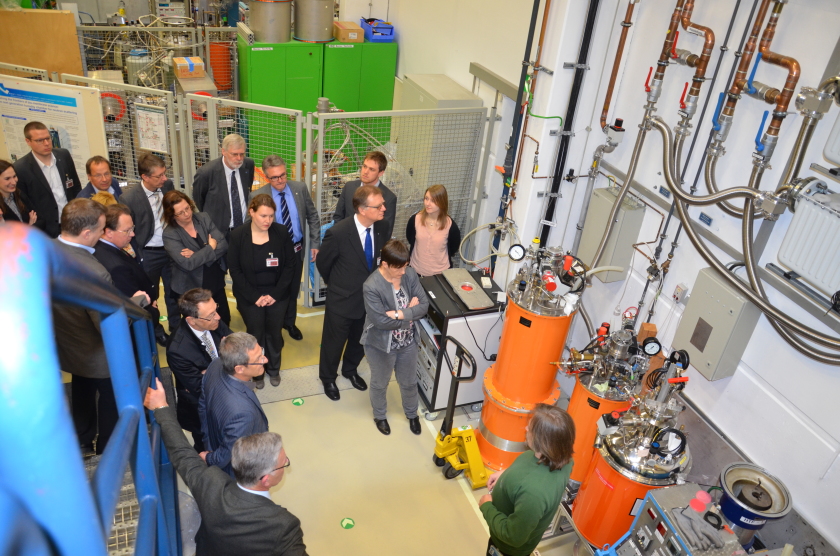Deutsche Gesellschaft für Materialkunde was a guest of HZB

Tour through the experimental hall of BER II.
From 15 to 16 March, the Deutsche Gesellschaft für Materialkunde, DGM (German association of materials science), held its closed board meeting and Advisory Council meeting at HZB. The experts took the occasion to visit the synchrotron source BESSY II and the neutron source BER II, gaining an insight into important future projects of HZB.
“It was a great pleasure to be host to the Deutsche Gesellschaft für Materialkunde, where we had the opportunity to present Helmholtz-Zentrum Berlin’s strategies and research infrastructures, which external researchers are also very welcome to use,“ says Prof. Dr. Anke Kaysser-Pyzalla, scientific director of HZB.
The board members of the DGM visited the control room and experimental hall of BESSY II on 15 March. On 16 March, the DGM Advisory Council toured the neutron guide hall at BER II and the CoreLab “Correlative Microscopy and Spectroscopy”, which is home to latest generation ZEISS electron and ion microscopes for use by external users and employees of HZB.
The Deutsche Gesellschaft für Materialkunde is dedicated to promoting continual advancements in topics, structures and careers in the field of materials science and engineering. Its strategies include fostering cooperation between universities, research institutions, companies, and national and international partners, and promoting new collaborative projects. The DGM organises many symposia and congresses that are also important information exchange platforms for many scientists of HZB.
(sz)
https://www.helmholtz-berlin.de/pubbin/news_seite?nid=14638;sprache=en
- Copy link
-
More time for discussions
The South African chemist Denzil Moodley is the first Industrial Research Fellow at HZB. He is playing a leading role in the CARE-O-SENE project. The Fellowship program aims to further accelerate the development of an efficient catalyst for a sustainable aviation fuel. An interview about the CARE-O-SENE project and why it is so important for scientists from industry and public research to work together.
-
Perovskites: Hybrid materials as highly sensitive X-ray detectors
New bismuth-based organic-inorganic hybrid materials show exceptional sensitivity and long-term stability as X-ray detectors, significantly more sensitive than commercial X-ray detectors. In addition, these materials can be produced without solvents by ball milling, a mechanochemical synthesis process that is environmentally friendly and scalable. More sensitive detectors would allow for a reduction in the radiation exposure during X-ray examinations.
-
Electrical energy storage: BAM, HZB, and HU Berlin plan joint Berlin Battery Lab
The Federal Institute for Materials Research and Testing (BAM), the Helmholtz-Zentrum Berlin (HZB), and Humboldt University of Berlin (HU Berlin) have signed a memorandum of understanding (MoU) to establish the Berlin Battery Lab. The lab will pool the expertise of the three institutions to advance the development of sustainable battery technologies. The joint research infrastructure will also be open to industry for pioneering projects in this field.
